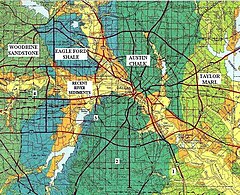Woodbine Group
| Woodbine Formation | |
|---|---|
| Stratigraphic range: Cenomanian: 96 million years[1] | |
 Cross section of Dallas-Fort Worth Metroplex geologic formations | |
| Type | Geological formation |
| Underlies | Eagle Ford Shale |
| Overlies | Washita Group |
| Area | Texas to Oklahoma |
| Lithology | |
| Primary | Sandstone |
| Other | Siltstone, mudstone |
| Location | |
| Region | North America |
| Country | United States of America |
| Type section | |
| Named for | Woodbine, Texas[2] |
| Named by | R. T. Hill[2] |
 Geologic map of Dallas, with Woodbine at left. | |
The Woodbine Group is a geological formation in east Texas whose strata date back to the Early to Middle Cenomanian age of the Late Cretaceous.[1] It is the producing formation of the giant East Texas Oil Field (also known as the "Black Giant") from which over 5.42 billion barrels of oil have been produced.[3] The Woodbine overlies the Maness Shale, Buda Limestone, or older rocks, and underlies the Eagle Ford Group or Austin Chalk. In outcrop the Woodbine Group has been subdivided into the Lewisville Sandstone, Dexter Sandstone, and/or Pepper Shale formations.[1] Thin-bedded sands of the Woodbine and Eagle Ford are collectively referred to as the "Eaglebine" oil and gas play in the southwestern portion of the East Texas region.[4]
Dinosaur and crocodilian remains are among the fossils that have been recovered from the formation.[5]
The Woodbine Group was first mapped and named by Robert T. Hill, known as the "Father of Texas Geology", for outcrops near the small town of Woodbine, Texas in 1901.[2] The Woodbine represents ancient river and delta systems that originated from erosion of the Ouachita Uplift in modern-day Oklahoma and Arkansas and the Sabine Uplift in modern-day Texas and Louisiana. Sediments from these deltas flowed into the East Texas and Brazos Basins of the ancient East Texas shelf.[6]
The Arlington Archosaur Site is a location in Arlington, Texas that currently excavates fossils from the Woodbine Group. It became available to access by the University of Texas at Arlington (UTA) in spring of 2008. UTA and the Dallas Paleontological Society have excavated at the site up to present day, where work continues.[7]
Vertebrate paleofauna
- Protohadros byrdi: "Partial skull, teeth, partial postcranium."[8] Found in Flower Mound, Texas in the early 1990s.
- Dallasaurus turneri: Full skeleton
- Woodbinesuchus byersmauricei: Lower jaw and a variety of postcranial elements, such as vertebrae, limb bones, shoulder and hip bones, and bony armor.[9]
- Unnamed theropod[10]
Other fossils
Other vertebrate fossils that have been identified in the Woodbine include lungfish, fish, turtles, sharks, and coprolites containing bones.[10] Invertebrate fossils found in the Woodbine include ammonites, Inoceramus, oysters, crustaceans, [11] and agglutinated foraminifera.[12]
See also
References
- ^ a b c Denne, R. A., Breyer, J. A., Callender, A. D., Hinote, R. E., Kariminia, M., Kosanke, T. H., Kita, Z., Lees, J. A., Rowe, H., Spaw, J. M., and Tur, N. (2016). Biostratigraphic and geochemical constraints on the stratigraphy and depositional environments of the Eagle Ford and Woodbine Groups of Texas: in Breyer, J. A. (ed.), The Eagle Ford Shale: A renaissance in U.S. oil production, AAPG Memoir 110, p. 1-84.
- ^ a b c Hill, R. T. (1901). Geography and geology of the black and grand prairies, Texas: Part 7—Texas: 21st Annual Report of the USGS, 666 p.
- ^ Dokur, M., and Hentz, T.F. (2012). Reservoir Characterization of the Upper Cretaceous Woodbine Group in Northeast Texas Field, Texas. AAPG Search and Discovery Article #20152.
- ^ Hentz, T. F., Ambrose, W. A., and Smith, D. C. (2014). Eaglebine play of the southwestern East Texas basin: Stratigraphic and depositional framework of the Upper Cretaceous (Cenomanian-Turonian) Woodbine and Eagle Ford Groups: AAPG Bulletin, v. 98, p. 2551-2580.
- ^ Weishampel, David B; et al. (2004). "Dinosaur distribution (Late Cretaceous, North America)." in Weishampel, David B.; Dodson, Peter; and Osmólska, Halszka (eds.): The Dinosauria, 2nd, Berkeley: University of California Press. p. 574-588. ISBN 0-520-24209-2.
- ^ Denne, R. A., and Breyer, J. A. (2016). Regional depositional episodes of the Cenomanian-Turonian Eagle Ford and Woodbine groups of Texas: in Breyer, J. A. (ed.), The Eagle Ford Shale: A renaissance in U.S. oil production, AAPG Memoir 110, p. 85-125.
- ^ About Arlington Archosaur Site
- ^ "Table 19.1," in Weishampel, et al. (2004). Page 417.
- ^ Lee, Yuong–Nam (1997). The Archosauria from the Woodbine Formation (Cenomanian) in Texas: Journal of Paleontology, v. 71, n.6, p. 1147–1156
- ^ a b Fossils at AAS
- ^ Stephenson, L. W. (1952). Larger invertebrate fossils of the Woodbine Formation (Cenomanian) of Texas: USGS Professional Paper 242, 226 p.
- ^ Loeblich, A. R. Jr. (1946). Foraminifera from the type Pepper Shale of Texas: Journal of Paleontology, v. 20, p. 130–139.
